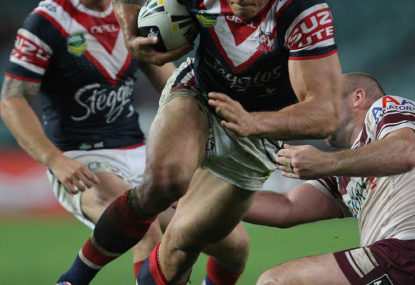Stuart
new author
Roar Rookie

In the current NRL climate where club and player loyalty are dependent on the power of the dollar, NRL clubs do their best to manage the funds to assemble a squad that will bring them premiership glory.
It’s always a challenge to get the balance right between recruitment and development, and this year is no different.
Sonny Bill Williams and Greg Inglis are only two of the biggest names that have moved between club and code in recent years chasing a premiership. With this in mind, I thought I’d take a look at the four sides remaining in the 2013 NRL title race and look at the numbers relating to purchasing players.
The stages of a player’s development vary between each player throughout junior footy, through to his first contract and eventually progression into the NRL. It is this final step that I believe is the most important.
If a club can see promise in a young man and turn him from a good player into a regular NRL starter they deserve much of the credit. They are the ones taking the risk on a young man and investing time, money and a place in their NRL squad for this potential star.
Given the number of players in the NRL compared with the state comps, the step from state footy to consistent NRL footy for an individual is quite significant.
I’ve used the player’s first 10 NRL games as a line in the sand for comparison and given that club credit for blooding an NRL player. Using the current squads, I’ve calculated how many players started their career at that club or were purchased from another side.
Given the romantic perception of the working class area of South Sydney and the rugby league landscape of Newcastle, the comparison with the Roosters and Manly is quite outstanding, especially considering the historical accusations aimed at the Roosters and Manly for purchasing players from other clubs.
These stats are based on sides named to play this weekend:
South Sydney:
Named a 20-man squad for this week, 11 players of which began their NRL careers in the Red and Green, meaning they’ve purchased 45% of their side from other clubs.
Manly:
Named a 20-man squad, 13 of whom began their NRL careers at Manly. They’ve purchased 35% of their team from other clubs.
Roosters:
Named a 19-man squad, 13 of whom began their NRL careers as a Rooster. Of the four remaining sides, they have the largest percentage of home-grown talent with a shade over 68%, having purchased a shade over 31% of their side from other clubs.
Newcastle:
Named their 17-man team, only eight of which began their careers at Newcastle. This means they’ve purchased over half their side from other clubs and have the lowest number of players of the four remaining teams who began their career at the club they represent today.
Interestingly, the players purchased from other clubs provide a fairly even spread across the league, with the 2013 preliminary finalists South Sydney having the largest number of players from a single other club with three players who began their careers at Melbourne.
Looking at grand final success over the past few years and the results lean toward clubs who have introduced a core group of players to the NRL and stuck by them.
In 2012 the premiership-winning Storm had 70% of their team start their NRL careers in Melbourne, while only 29% of the runners-up Bulldogs started their career at Canterbury.
In 2011, Manly prevailed, again with a large number of players who started their careers at the Sea Eagles. In fact, in recent history the lowest percentage was St. George Illawarra, a Wayne Bennett-coached side, with only 53% of players starting their careers at the Dragons.
So, history suggests that clubs can’t simply buy a premiership team.
What does all this mean for 2013? Well, I believe history will continue to reward clubs who ‘largely’ produce their own teams and we’ll see the Roosters lift the trophy.
Hopefully, we’ll see clubs take note of this trend and club/player loyalty will have a renaissance.